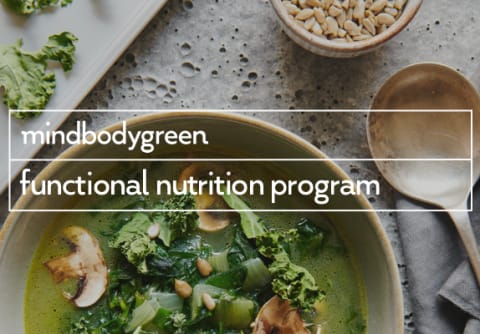Advertisement
SIBO Was Destroying My Gut. Here's What I Wish I'd Known

If you'd asked me back in 2017 if I ate a gut-friendly diet, I would have given an emphatic yes.
I'd recently come off a yearlong odyssey healing my Hashimoto's one lifestyle change at a time, and as part of it had learned the do's and don'ts of living with my microbiome in mind. I was eating plenty of fiber, dousing my grain bowls in kefir green goddess dressing and kimchi, and washing it all down with homemade kombucha.
Yet despite my habit overhaul, about a year ago, I started to notice some digestive woes creeping back into my life. My usual diet—full of woody veggies and fermented foods that, in theory, supported good gut health—was starting to make me feel bloated after meals. And I began to worry that my habitual burping, and more than occasional tooting, was becoming a regular companion soundtrack to my husband's and my nighttime Netflix binges.
What is SIBO?
After I decided to see a doctor for a full work-up, the diagnosis I received was SIBO: small-intestinal bacterial overgrowth.
Small-intestinal bacterial overgrowth is exactly what it sounds like: a type of dysbiosis1, which simply means an imbalance in the trillions of bacteria that take up residence in your gut. In the case of SIBO, however, the issue is not necessarily the ratio between good, beneficial bacteria and bad, pathogenic bacteria (though that could be part of it). Rather, the main problem is location, not type.
Though critters colonize all sections of our alimentary canal, the majority of it is found in the large intestine (also known as the colon), where it assists in the final step of the digestive labyrinth and prepares for evacuation.
The small intestine, on the other hand, is where your food intermingles with digestive juices, nutrients are absorbed into the bloodstream, and your body reaps the rewards of what you've just put in it. It's not a place where bacteria have much of a function. In fact, as is the case with SIBO, their increased presence causes a host of issues.
Since these are living organisms with their own palates and cravings, bacteria in your small intestines means there are other mouths at the table competing for your dinner. And when there's not enough nourishment to be had, they turn to the next best thing (you!), which can lead to leaky gut and food sensitivities.
5 tips for healing SIBO.
Part of the SIBO treatment plan is taking on a low-FODMAP diet, which limits easily fermentable carbohydrates—in other words, your bacteria's favorite foods. These were some of the foods that, in the absence of knowing about my SIBO, I added to my plate night after night in the name of good gut health.
With SIBO, I quickly learned there are numerous contradictions and unknowns. But as I hopped down the rabbit hole and began honing a game plan—even starting a podcast on the subject!—I learned some best practices that helped me inevitably kick this complex condition.
Now that I'm SIBO-free, I want to share some of the tips I've learned from interviewing the leading SIBO experts across the world on my podcast, SIBO Made Simple. These are the things I wish I'd known when I was first diagnosed and advice that you should keep in mind when designing a SIBO diet adventure of your own:
1. A SIBO diet helps with symptoms but often isn't enough to kill the bacteria on its own.
The most common approach for a SIBO diet is one that's low in FODMAPs. Some of the more restrictive versions also limit grains and other refined carbohydrates. These diets can help reduce the number of bacteria in your small intestine by effectively starving them out. But unless you eat a completely carbohydrate-free diet, it's unlikely that you will completely eradicate the population.
Though diet can certainly help you heal your gut from SIBO—improving leaky gut and alleviating symptoms—it's not the root cause of your SIBO and therefore usually not the lone cure.
2. Decide on a plan of attack and commit.
The many types of dietary approaches and timing of these tactics in conjunction with other medications can be a big source of confusion. Some people argue that you shouldn't begin a SIBO diet until after you've completed your round of treatment. This ensures that your bacteria don't go dormant due to lack of food sources and, therefore, can be fully eradicated by whatever antimicrobials you're taking. Other practitioners say that clinically they don't notice much of a difference, and in fact, if your SIBO symptoms are quite severe, it helps to begin with diet first to reduce some of the bacteria, mitigate the intensity of "die-off" effect, and alleviate the gastro pain that led you to take a SIBO test in the first place.
Here are two hybrid methods:
1. Begin your antimicrobials, and toward the end of the treatment, begin your low-FODMAP diet, knowing that it will take a few weeks to get the hang of the restrictions anyway.
2. Try the diet for a few weeks until your symptoms are more under control and your gut has had a chance to heal, then begin reintroducing small quantities of high-FODMAP foods or grains in tandem with starting your medication. This will stir up some of the remaining critters at the same time as you begin taking pills to kill them.
Both tactics have been touted clinically (for the record, no SIBO diet has been scientifically proved in studies), so don't stress about their opposing nature; pick one and stick with it.
3. Don't strive for perfection.
The level of restrictiveness of a SIBO diet can breed some unhealthy food tendencies. I get it: For many people, limiting FODMAPs was the first time in many years that their IBS symptoms dissipated. It can make you feel empowered. It can make you grateful that your food is one thing you can control. But it can also lead to unhealthy perfectionism.
If you take away anything from points 1 and 2 above, it's that being perfect on the low-FODMAP front will not make your SIBO go away. And in fact, being willing to be uncomfortable and reintroduce food sources to your bacteria can actually help you eradicate them completely. It will also lead to better long-term gut health going forward.
4. Remember that a SIBO diet is therapeutic, not a long-term solution for your gut.
The goal of any SIBO treatment–diet, supplements, or otherwise–is to get you eating a diverse, nutrient-rich array of vegetables, no matter how many fermentable sugars they contain. Staying on a restrictive diet long term is not necessary for prevention, and may in fact—according to studies on the low-FODMAP diet—be damaging to the overall health of your bacterial ecosystem in the large intestine. When you starve bacteria in one place, you do so everywhere.
Many practitioners don't recommend staying on a strict low-FODMAP diet for longer than two months.
5. Your healing plan should focus just as much on what you're eating as how you're eating it.
As I mentioned, the root cause of SIBO oftentimes has to do with structural issues or a failure of the migrating motor complex2 (MMC), not an imperfect diet. Just as important as what you're eating is how you're eating it. Make sure you're chewing your food thoroughly.
Since your MMC kicks in during a fasting state of 90 minutes or more, it's important not to snack between meals. Consider light intermittent fasting—12 to 16 hours overnight. (For more information, check out our complete guide to intermittent fasting). Drinking lemon water or apple cider vinegar before meals may stimulate stomach acid, which helps kill bacteria coming into your system and prevents more of a buildup in the small intestine. And most importantly, enjoy your food.
Stress is the worst possible thing for digestive health. Don't let any new dietary restrictions get in the way of your pleasure—it won't do your gut any favors.
Watch Next
Enjoy some of our favorite clips from classes
Enjoy some of our favorite clips from classes
What Is Meditation?
Mindfulness/Spirituality | Light Watkins
Box Breathing
Mindfulness/Spirituality | Gwen Dittmar
What Breathwork Can Address
Mindfulness/Spirituality | Gwen Dittmar
The 8 Limbs of Yoga - What is Asana?
Yoga | Caley Alyssa
Two Standing Postures to Open Up Tight Hips
Yoga | Caley Alyssa
How Plants Can Optimize Athletic Performance
Nutrition | Rich Roll
What to Eat Before a Workout
Nutrition | Rich Roll
How Ayurveda Helps Us Navigate Modern Life
Nutrition | Sahara Rose
Messages About Love & Relationships
Love & Relationships | Esther Perel
Love Languages
Love & Relationships | Esther Perel
What Is Meditation?
Box Breathing
What Breathwork Can Address
The 8 Limbs of Yoga - What is Asana?
Two Standing Postures to Open Up Tight Hips
How Plants Can Optimize Athletic Performance
What to Eat Before a Workout
How Ayurveda Helps Us Navigate Modern Life
Messages About Love & Relationships
Love Languages
Advertisement

This Supplement May Remarkably Benefit Those With A High Risk Of Alzheimer’s
Molly Knudsen, M.S., RDN

Want To Be Metabolically Healthy? Study Shows An Underutilized Approach
Molly Knudsen, M.S., RDN

This Supplement May Remarkably Benefit Those With A High Risk Of Alzheimer’s
Molly Knudsen, M.S., RDN

Want To Be Metabolically Healthy? Study Shows An Underutilized Approach
Molly Knudsen, M.S., RDN

This Supplement May Remarkably Benefit Those With A High Risk Of Alzheimer’s
Molly Knudsen, M.S., RDN

Want To Be Metabolically Healthy? Study Shows An Underutilized Approach
Molly Knudsen, M.S., RDN

This Supplement May Remarkably Benefit Those With A High Risk Of Alzheimer’s
Molly Knudsen, M.S., RDN

Want To Be Metabolically Healthy? Study Shows An Underutilized Approach
Molly Knudsen, M.S., RDN








